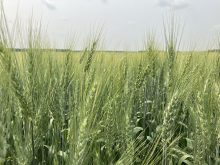A family of ‘weird’ proteins make plants sick by punching holes in their cell membranes and forcing them to drink
Plant pathogens have become extremely efficient at infecting crops and injecting harmful proteins into cells for their own benefit. From brown spot in beans, bacterial speck in tomatoes or fire blight in fruit trees, a family of proteins called AvrE/DspE causes havoc in hundreds of crops worldwide.
Now, researchers at Duke University in North Carolina have discovered that these protein molecules make plants sick by folding themselves into a straw-like hollow tube to punch a hole in the plant cell membrane and force the host to drink, leading to dark water-soaked spots on a plant’s leaves, the early onset of infection.
Read Also

Alberta irrigation project on grasslands approved
Environmental concerns raised by Alberta conservation groups over irrigation expansion project within rural municipality
While scientists were aware of the sequencing of amino acids that linked to form these bacterial proteins like beads on a string, they didn’t know previously just how the amino acid string folded into the cylindrical funnel shape.
“Why do pathogens ‘want to’ send such a large and complicated tubular channel protein to release water from plants, especially since conventional water channels are much smaller and simpler?” said Sheng-Yang He, professor of biology. “While we do not have an answer, some type of co-evolution between plants and bacteria is likely the cause. It is also possible that these water channels release other molecules, in addition to water, from plant cells to benefit bacteria. Regardless, these water channel proteins are now prevalent in many bacterial pathogens, suggesting that they are highly effective weapons.”
Part of the challenge facing He and his research group was that the proteins in the AvrE/DspE family are huge. Proteins are long chains of individual units called amino acids. While an average bacterial protein might be 300 amino acids long, AvrE/DspE family proteins are 2,000 units long. While researchers have searched for other similar protein sequences, none with any known functions have shown up.
“They are weird proteins,” said He.
He said, that, in addition to creating these water-soaked environments, bacterial pathogens also need to evade a plant’s immune system. There is evidence that creating the water-soaked environment may be a more ancient disease-inducing process than immune evasion alone.
The news release stated that, once bacteria enter a plant’s leaves, one of the first areas they encounter is a space between cells called the apoplast, a dry area between cell membranes to allow gas exchange for photosynthesis. But when bacteria invade, this area becomes waterlogged, creating a moist, cozy place for the bacteria to feed and multiply at the expense of the plant’s health.
To better understand the proteins, the researchers used an artificial intelligence program to predict what three-dimensional shape a given string of amino acids would look like. They already knew that the bacteria could evade the plant’s immune system but, when they first looked at the protein’s 3D structure, they knew something else was going on. They compared AI predictions for bacterial proteins infecting various crops, including pears, apples, tomatoes and corn, and those profiles all pointed to a similar 3D structure that looked like a mushroom with a cylindrical stem like a straw and a bundle on the top.
They studied the 3D model for the fire blight protein that infects pear, apple and crabapple. The study showed that, while the outside of the straw-like structure was water-resistant, the hollow inner core had a compatibility with water, which allowed the protein to waterlog the leaf’s interior through a water channel approach.
“Because this strategy is used by many bacterial pathogens, it must be a highly effective one,” said He. “I’m glad that we now have some insight into this macabre strategy and that we are lucky enough to have a potential method of disarming it.”
To test the water channel hypothesis, the team worked with Ke Dong, biology professor at Duke University, and Felipe Andreazza, a postdoctoral associate in Dong’s lab. They added the gene readouts for the proteins AvrE and DspE to frog eggs that were used as cellular factories for making the proteins. The eggs were then placed in a saline solution, but they quickly swelled and burst with too much water.
To disarm the bacterial proteins and block their water channels, the team turned to nanoparticles. He’s senior research associate, Kinya Nomura, focused on a class of tiny spherical nanoparticles called PAMAM dendrimers widely used in drug delivery and gene therapy. The appeal of these dendrimers is that they have unparalleled molecular uniformity, defined size and shape characteristics, and a multifunctional surface. They can be made with precise diameters in a laboratory.
“We were tinkering with the hypothesis that if we found the right diameter chemical, maybe we could block the pore,” said He.
They tested different-sized particles and identified one that looked to be the right size to block the water channel protein produced by the fire blight pathogen Erwinia amylovora. Using frogs’ eggs engineered to synthesize this protein, they doused them with the PAMAM nanoparticles. Water stopped flowing into the eggs and they did not swell or burst.
They applied the same approach to Arabidopsis plants infected with the pathogen Pseudomonas syringae, which causes bacterial speck. They treated the diseased plants with the channel-blocking nanoparticles. The treatment prevented the bacteria from embedding in the plants’ cells, reducing pathogen concentrations in the leaves by 100-fold.
Expanding on the success of the research, the channel-blocking approach was tested on other bacterial infections. They treated pear fruits exposed to the bacteria Erwinia amylovora, which causes fire blight disease. The fruits never developed symptoms and the disease failed to advance.
“It was a long shot, but it worked,” said He in the news release. “We’re excited about this.”
Encouraged by the results and the potential for developing a whole new line of attack against plant pathogens, the team is advancing the research into a crop field setting.
The research findings should be encouraging for crop farmers. He said that, because AvrE/DspE-containing bacterial pathogens attack many crop species, the channel-blocking nanoparticle approach in principle may be widely applicable for a variety of grain crops and fruits. In addition, this approach could offer a smarter, more target-specific method for controlling plant diseases.
“Because the nanoparticle inhibitors specifically block a key pathogen strategy, instead of nonspecifically killing many bacteria, as many antibiotics do, they could potentially offer a smarter, pathogen-selective method for disease control without harming the surrounding microbiome, for example.”
The research was published in the journal Nature.

















